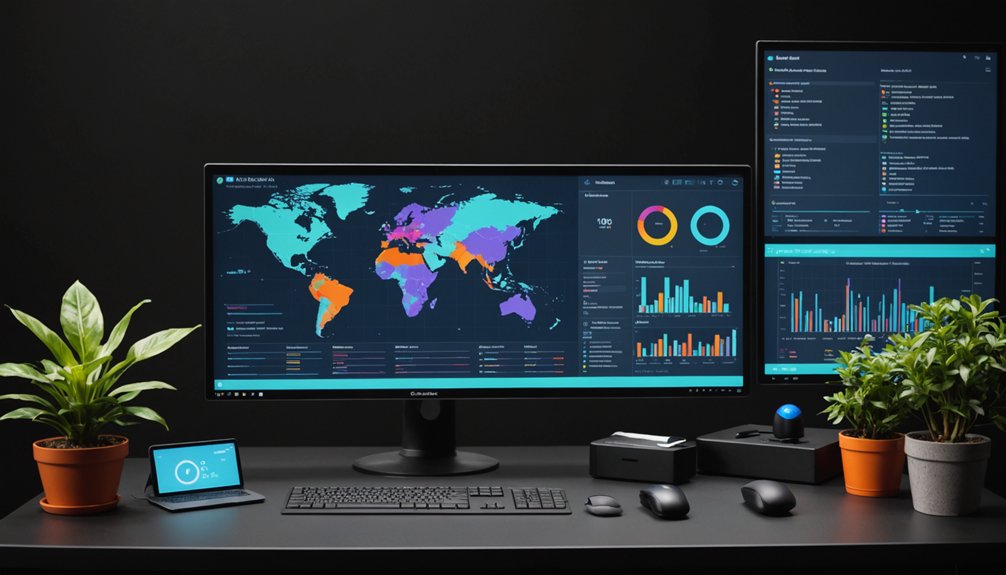In 2025, SEO isn’t just about keywords anymore. It’s a whole new game. AI algorithms like BERT now understand your actual intent, making keyword stuffing useless. Voice search dominates, requiring conversational content that answers real questions. Core Web Essentials are non-negotiable ranking factors—slow sites simply don’t compete. Content clustering builds authority while structured data powers visibility. The days of SEO shortcuts are dead. Adapt or watch your traffic vanish.
Explorer Insights
- AI-powered search prioritizes natural language content that addresses user intent over traditional keyword optimization techniques.
- Voice search optimization requires conversational keywords, structured data, and concise answers formatted for featured snippets.
- Core Web Vitals (LCP, INP, CLS) directly impact rankings, with specific performance targets essential for visibility.
- Content clustering with pillar pages establishes topical authority and strengthens E-E-A-T signals for search engines.
- Local SEO demands complete Google Business Profiles, consistent NAP data, and reputation management through customer reviews.
AI-Powered Search Algorithms: Understanding the New Landscape
Google’s algorithm updates in 2025 aren’t messing around—they’ve completely changed the SEO game with BERT and RankBrain at the helm.
You’ll need to abandon those old-school keyword stuffing tactics and focus on content that actually answers questions people ask in real life.
Let’s face it, if you’re not adapting your strategy to accommodate AI’s understanding of natural language and user intent, your website might as well be invisible.
In 2025, a surge in AI overviews and generative summaries within search results is reshaping SEO strategies, demanding content that prioritizes user intent and delivers comprehensive, helpful answers.
Key Google Algorithm Updates in 2025
While SEO professionals scramble to keep up, AI and machine learning have completely transformed how search engines deliver results in 2025.
Google’s algorithm updates this year? Game changers. BERT’s natural language processing now dissects user intent with scary accuracy. You’re not just optimizing for keywords anymore—you’re satisfying search intent. Period.
Core web essentials aren’t optional. Slow sites? Dead sites. Mobile-unfriendly? Forget ranking.
Semantic search capabilities have evolved beyond simple keyword matching. Now, it’s about thorough content that actually answers questions people are asking. AI-powered search understands context, not just words.
The rise of zero-click searches means SEO strategies must adapt or die. Your content needs to work harder to earn those precious clicks when Google’s serving answers directly in results.
Optimizing for Core Web Vitals not only enhances user engagement and reduces bounce rates, but in competitive niches it can provide a subtle but meaningful SEO advantage when other ranking factors are evenly matched.
Adapting Your SEO Strategy to Algorithm Changes
As artificial intelligence reshapes search engines in 2025, your old SEO playbook is basically worthless. Seriously. Those keyword-stuffing tricks? Dead.
SEO strategies must now align with conversational patterns as BERT and RankBrain interpret natural language. Tough luck if you’re still obsessing over exact-match keywords. Focus on semantic search instead.
User experience isn’t just fancy talk—it’s algorithm currency. Your content updates better provide value, not fluff. Search rankings live and die by metrics like bounce rates and click-throughs. Yeah, they’re actually watching those.
Monitor algorithm changes religiously—or watch your traffic tank overnight. The algorithms don’t care about your feelings or your quarterly goals.
Build topic clusters, not keyword lists.
And for heaven’s sake, stop treating AI like a passing trend. It’s your new boss.
Unlock new opportunities by using ChatGPT to generate long-tail keywords and organize them into topical clusters that strengthen your site’s authority and connect directly with audience intent.
User Intent Optimization: Beyond Keywords to Conversational Search
Voice search isn’t just a trend anymore—it’s reshaping how people find what they need online.
You’ll need to adapt your content for the way people actually talk, not just how they type, as smart speakers and digital assistants handle over a billion searches monthly.
This shift to conversational queries means your old keyword strategy might be as useful as a flip phone at a tech convention.
AI-driven advancements in real-time language translation are also enabling more natural and accurate communication across languages, setting new expectations for how users search and interact online.
The Rise of Voice Search and Natural Language Queries
Since smart speakers invaded our homes, SEO has faced a radical shift. By 2025, over half of all searches will be voice-based. Let that sink in. Your keyword targeting strategies? They need a complete overhaul.
Natural language processing has changed everything. People don’t type “best coffee shop NYC” anymore—they ask, “Where can I get a great latte near me?” Big difference.
| Voice Search Element | What Changed | How to Adapt |
|---|---|---|
| Query Format | Complete sentences | Use question keywords |
| Result Source | Featured snippets | Provide concise answers |
| Context | Conversational | Natural language focus |
| Technical Need | Schema markup | Implement structured data |
Optimizing for voice means focusing on long-tail and conversational keywords and ensuring your content answers real questions directly and concisely.
Core Web Vitals and Experience Metrics in 2025
Core Web Vitals aren’t just fancy metrics—they’re now make-or-break ranking factors in 2025’s competitive search landscape.
You’ll need to optimize your Largest Contentful Paint to under 2.5 seconds, maintain Interaction to Next Paint below 100 milliseconds, and keep Cumulative Layout Shift scores under 0.1 if you want any shot at ranking well.
Let’s face it: users bail on slow, jumpy sites faster than you can say “bounce rate,” so investing in performance monitoring tools isn’t optional anymore.
Regular SEO audits are also vital to identify technical issues that can impact Core Web Vitals and overall site performance.
Measuring LCP, INP, and CLS for Better UX
Three critical metrics now dominate the SEO landscape in 2025, and you can’t afford to ignore them.
Largest Contentful Paint (LCP), Interaction to Next Paint (INP), and Cumulative Layout Shift (CLS) are the Core Web Essentials that search engines obsess over. Your rankings literally depend on them.
Aim for LCP under 2.5 seconds, INP below 200 milliseconds, and CLS maintaining 0.1 or lower. Trust me, these aren’t just fancy acronyms—they’re your website’s lifeline.
- Picture your visitors abandoning ship when your content takes forever to load.
- Imagine their frustration when buttons don’t respond to their frantic clicking.
- Visualize the rage when text jumps around as they’re about to tap something.
Monitor these metrics religiously. Better user experience means lower bounce rates. Simple math.
Bolstering your site’s mobile-first indexing approach directly complements Core Web Vitals optimization, positioning your pages for even greater ranking success in a mobile-dominated search environment.
Tools to Audit and Improve Core Web Vitals
Armed with knowledge about these crucial metrics, you’ll need powerful tools to audit and improve them.
Google’s PageSpeed Insights is your go-to weapon—brutal honesty about your site’s core web fundamentals in seconds. No sugar-coating here.
Lighthouse integration in Chrome DevTools lets you analyze performance bottlenecks right where you build. Convenient? Absolutely. Critical? You bet.
For ongoing monitoring, Chrome User Experience Report (CrUX) dishes out real-world user experience data. Because what your users actually experience matters more than what your developer thinks.
WebPageTest offers deeper dives for the truly obsessed. Search engine rankings don’t improve by accident, folks.
Fix these issues promptly. Your competitors are already doing it. Trust me, your bounce rate won’t fix itself.
As digital security evolves, leveraging AI-driven content moderation enables websites to not only enhance user safety but also maintain trust and mitigate emerging online harms in 2025.
Zero-Click Search Strategies for Maximum Visibility

Featured snippets are your golden ticket in a world where 60% of Google searches never result in a click.
You’ll need clear, structured headings and direct answers to common questions if you want Google to showcase your content at position zero.
Adding schema markup isn’t optional anymore—it’s the difference between being seen and being invisible in 2025’s zero-click landscape.
Optimizing for user intent over exact phrase matching is a proven technique to capture featured snippets and drive greater SEO visibility.
Featured Snippets and How to Win Them
People Also Ask boxes are goldmines for zero-click visibility—they’re basically free real estate for your brand.
You’ll want to monitor which questions appear related to your keywords, then craft content that directly addresses these queries with clear, concise answers.
Structuring your responses with the question as a subheading and providing a straightforward answer in the first paragraph isn’t just good practice, it’s practically handing search engines what they’re begging for.
By focusing on user intent and context, you can ensure that your answers are not only visible in featured snippets and People Also Ask boxes, but also provide the comprehensive value that search engines reward with higher rankings.
Optimizing for People Also Ask Boxes
While most SEO pros obsess over rankings, they’re missing a goldmine hiding in plain sight.
People Also Ask boxes are zero-click search goldmines. By optimizing with structured data and addressing user intent through detailed content, you’ll fill content gaps your competitors don’t even know exist.
- Questions floating above search results, your brand’s answers hovering just a click away
- Schema markup signaling to Google: “Hey, I’ve got what they’re asking for!”
- Content that anticipates questions before users even realize they’ve them
Voice Search and Multi-Modal Content Optimization
As smart speakers continue flooding our homes and offices, voice search has exploded to over 50% of all searches—yeah, you read that right—half of all search queries now happen through voice.
Scary? Maybe. Unavoidable? Absolutely.
Voice search optimization requires rethinking your content strategy. Users speak differently than they type. Obvious, right? Implement long-tail keywords mimicking conversational phrases people actually use. No robotic text allowed.
Multi-modal content is your secret weapon for user engagement. Mix text, images, and video. One format? Boring.
Structured data isn’t optional anymore. It’s your ticket to getting featured in those coveted direct answers. Schema markup tells search engines exactly what your content means, not just what it says.
Fast. Clear. Concise. That’s what wins in voice search.
E-E-A-T Signals: Building Authority in the AI Era

In the AI-dominated landscape of 2025, your author profiles aren’t just digital window dressing—they’re essential E-E-A-T signals that prove you know what you’re talking about.
Google’s algorithms now scrutinize credentials and real-world experience with unprecedented sophistication, so those neglected bio pages need serious attention.
You’ll also need a regular schedule for content updates because stale, outdated information screams “untrustworthy” to both AI systems and human visitors.
Demonstrating Expertise with Author Profiles
Because Google’s algorithms have grown increasingly sophisticated, your author profiles can’t just be an afterthought anymore.
They’re essential E-E-A-T signals that demonstrate expertise and boost content quality. A detailed bio highlighting your qualifications and credentials tells Google you’re not just some random person spouting nonsense. Trust me, it matters.
- A professional headshot with you looking thoughtful (bonus points for glasses—instant credibility!)
- Clear listing of degrees, certifications, and years of experience (no, your high school diploma doesn’t count)
- Links to published works or speaking engagements that prove you know your stuff
Update these profiles regularly. Seriously. Your achievements from 2018 aren’t impressing anyone now.
Link to reputable sources, add citations, and watch your trustworthiness soar.
Updating Content for Accuracy and Freshness
Gone are the days when you could publish content once and forget about it. Search engines aren’t stupid anymore. They reward content freshness with better rankings—period.
Implementing a systematic refresh schedule, preferably quarterly, keeps you competitive. Think about it: outdated content screams “I don’t care!” to both users and algorithms.
Strong E-E-A-T signals matter tremendously. Include author bios, cite credible sources, and update statistics regularly. It’s not just about looking good; it’s about being trustworthy.
Remember user intent when updating. People search differently now than they did six months ago. Your content should evolve accordingly.
High-traffic pages deserve special attention. They’re your money-makers! Update them first, and watch engagement metrics climb. Fresh content equals happy visitors. Happy visitors equal better rankings. Simple math, really.
Semantic SEO and Structured Data Implementation
Semantic SEO isn’t just a buzzword anymore—it’s your ticket to ranking in 2025.
You’ll need to implement schema markup correctly if you want search engines to actually understand your content, not just crawl it.
Creating topic clusters that establish clear relationships between your content pieces will strengthen your semantic footprint, but don’t forget to regularly test your structured data with tools like Google’s Rich Results Test—broken schema is worse than no schema at all.
Implementing Schema Markup for SEO
Four powerful words for your 2025 SEO strategy: structured data changes everything.
Schema markup isn’t just code—it’s your ticket to better search visibility. Without it, you’re invisible in half the searches that matter. Implement it correctly, watch your organic traffic climb. Simple as that.
- Visual rich snippets that make users stop scrolling and click your result instead
- Product ratings appearing directly in search results, screaming credibility to potential customers
- FAQ dropdowns that dominate search real estate, pushing competitors down the page
Your semantic SEO depends on structured data. Period.
Regular audits aren’t optional—they’re essential. Got broken schema? Kiss your rankings goodbye.
Different content types need different markup: Articles, Products, Events, FAQs. Don’t mess this up.
Topic Clusters and Semantic Relationships
While schema markup gives you the technical edge, topic clusters deliver the knockout punch your content strategy needs.
They’re not just fancy organization—they’re your ticket to search dominance in 2025.
Build your clusters around pillar pages, connecting related articles that actually make sense together. Not random stuff.
Semantic SEO isn’t optional anymore; it’s survival.
You’re probably missing massive content gaps right now. Yeah, you. Your competitors aren’t.
User intent drives everything. Period. Search engines are getting freakishly good at understanding what people actually want, not just what they type.
Structured data amplifies your cluster strategy, making connections crystal clear to search engines. They’re not mind readers (yet).
The days of keyword stuffing are dead. Buried. Gone. Context matters more than ever.
Tools for Testing and Validating Structured Data
Structured data looks impressive on paper, but means nothing if it’s broken. Search engines understand your content better when structured data is properly implemented, but they’ll ignore it completely if it’s flawed. That’s why tools for testing and validating structured data are non-negotiable in 2025. The Structured Data Testing Tool gives you instant feedback—errors, warnings, everything that might prevent those coveted rich snippets from appearing.
- Your structured data sits invisible in your code, silently communicating with Google’s crawlers like a secret handshake.
- Rich snippets stand out in search results like neon signs in a sea of plain text.
- Schema.org vocabulary acts as the universal translator between your content and search engines.
Regular validation isn’t optional. It’s survival.
Mobile-First Indexing: Advanced Techniques
Your responsive design isn’t just a nice-to-have anymore—it’s the foundation of your entire SEO strategy in 2025.
You’ll need to guarantee perfect content parity between desktop and mobile versions, because Google’s watching both but judging you primarily on mobile.
Responsive Design Best Practices
As mobile devices continue dominating internet traffic, responsive design isn’t just nice to have—it’s essential for survival in the 2025 digital landscape. Your site must adapt instantly to any screen size, or you’ll lose visitors faster than you can say “bounce rate.”
Implementing flexible grid layouts with responsive media queries isn’t optional anymore—it’s the baseline for mobile-first indexing success.
- Touch-friendly navigation buttons that don’t require users to pinch, zoom, or squint—because nobody’s got time for that frustration
- Images that automatically resize without distortion, maintaining visual appeal while keeping page loading speed lightning-fast
- Content that reflows seamlessly between devices, eliminating horizontal scrolling—the ultimate user experience killer
Test constantly. Different devices. Various screen sizes. No exceptions.
Ensuring Parity Between Desktop and Mobile Content
While everyone obsesses over desktop design, Google’s evaluating your mobile site first—period.
Your beautifully crafted desktop experience? Worthless if your mobile version doesn’t match up.
Let’s face it: over half of global traffic comes from smartphones. Users expect consistency. When content disappears on mobile, they notice—and leave. One second of delay costs you 7% in conversions. Ouch.
Responsive design isn’t optional anymore; it’s survival. Your website must adapt seamlessly across devices, or prepare to vanish from search results.
Conduct regular audits comparing both versions. Found discrepancies? Fix them. Yesterday.
The mobile-first indexing reality is brutal but simple: deliver identical content, maintain fast-loading websites on all platforms, and prioritize user experience everywhere—or watch your competitors outrank you.
Local SEO and Hyperlocal Search Optimization

In 2025, local SEO isn’t just nice-to-have, it’s do-or-die for businesses wanting actual customers walking through their doors.
Your Google Business Profile deserves obsessive attention—complete with accurate hours, recent photos, and responses to every single review (yes, even the one-star rants).
Building local citations across directories while creating neighborhood-specific content will cement your position as the go-to option when someone mutters “near me” into their device.
Optimizing Google Business Profiles
Local visibility isn’t optional anymore—it’s survival. With 46% of Google searches hunting for local info, your Google Business Profile needs to be spot-on. Complete every detail—name, address, phone number, hours—consistency matters if you want to show up when customers search.
Keep your profile fresh. Post updates, offers, events. Google’s algorithm loves activity, and frankly, so do customers. Keywords matter here too—strategic placement in your descriptions connects user queries to your business.
- A smartphone screen illuminating with your business appearing in the local pack, standing out among competitors
- A customer’s satisfied smile as they easily find your accurate hours and location
- Your phone ringing with new business after a potential customer discovers your five-star reviews
Building Local Citations and Backlinks
Beyond your Google Business Profile, your local SEO game needs serious muscle—enter citations and backlinks.
Let’s be real: consistency is everything. Your NAP (name, address, phone) must match across every online directory. Period.
Local backlinks aren’t just nice-to-have—they’re essential. When community websites link to you, search engines practically bow down. It’s a digital vote of confidence, folks.
Ready to get hyperlocal? Target specific neighborhoods with precise keywords. Trust me, nearby customers are searching.
Don’t forget to claim that Google My Business listing. Without it, you’re invisible in local pack results. Brutal but true.
Want organic citations? Sponsor local events. Show up in your community. These relationships build natural backlinks—and they’re worth their weight in gold.
Leveraging Reviews and Local Content
Your online reputation isn’t optional anymore—it’s everything. With 97% of consumers reading online reviews before making decisions, you’d be crazy not to prioritize them.
Google My Business optimization delivers 7x more clicks—yeah, you read that right. And hyperlocal search optimization? It’s targeting those 46% of Google searches looking for stuff right around the corner from where people stand.
- A neighborhood coffee shop showcasing customer photos enjoying their signature lavender latte on a rainy Seattle morning
- A hardware store featuring DIY project testimonials from local homeowners fixing storm damage
- A family dentist sharing before-and-after smile transformations with authentic patient stories
User-generated content builds trust—79% of people believe online reviews as much as recommendations from friends.
Use local keywords. Be relevant. Get specific. Because 76% of “near me” searches lead to store visits within 24 hours.
Content Clustering and Topical Authority Building

Content clustering isn’t just a fancy SEO term—it’s your ticket to dominating search in 2025.
You’ll need to create thorough pillar pages that link strategically to supporting content, building a web that shows Google you’re the real deal on your topic.
Measuring your topical authority through metrics like organic visibility and backlink quality will tell you if your clustering strategy is working or if it’s time to regroup.
Creating Pillar Pages and Supporting Content
While search engines grow increasingly sophisticated, the fundamental organization of your SEO strategy remains critically important.
Building content clusters around extensive pillar pages isn’t just nice—it’s necessary. Your pillar pages should tackle broad topics thoroughly while supporting content dives into the nitty-gritty details. This structure signals topical authority to search engines. Period.
Don’t forget E-E-A-T principles in everything you create. Experience matters. Expertise shows. And Google knows the difference.
- A sprawling pillar page, filled with authoritative insights, linking outward like a digital spider’s web
- Laser-focused supporting articles, each answering one specific question in exhaustive detail
- A quarterly content refresh schedule, because outdated content is basically digital compost
Update or die. That’s just how SEO works in 2025.
Internal Linking Strategies for SEO
How effectively do your links work together behind the scenes? Let’s be real—most websites are a maze of disconnected pages. Big mistake.
Content clustering is your secret weapon. Group related content around pillar pages to build topical authority. Search engines eat this up. They understand your site better, you rank better. Simple math.
Your internal linking structure needs hierarchy. Crystal clear, no confusion. Users bounce when they’re lost, and so do crawlers.
Drop contextual links in your content. They’re not just pretty—they keep visitors hooked, exploring more pages. Longer sessions. Better SEO performance.
And those anchor texts? Make them count. “Click here” tells nobody anything. “Complete guide to crawl efficiency” does.
Audit regularly. Dead links kill user experience. Fix them.
Measuring and Improving Topical Authority
Five simple metrics reveal your true topical authority—and most sites fail at all of them. Your content clustering efforts won’t matter if you can’t prove they’re working. Track organic traffic growth, bounce rates, and time-on-page across your topic clusters.
Internal linking strategies distribute authority, but they’re useless without measurement.
- Visualize your topic clusters as spider webs, with strong silken threads connecting each piece of valuable content.
- Picture search engines crawling through your site like curious explorers, discovering pathways to knowledge.
- Imagine user engagement as heat signatures, glowing bright red on pages where visitors find exactly what they need.
Don’t just publish and pray. Measure everything. Search engine understanding improves when your content demonstrates clear topical relationships.
Update cornerstone content regularly. Be obsessive about it. Your competitors certainly are.
Frequently Asked Questions
How Will Sustainable SEO Practices Impact Long-Term Brand Visibility?
Playing the long game in SEO isn’t optional anymore. Sustainable practices build trust with both users and search engines.
You’ll see consistent visibility that doesn’t vanish with algorithm updates. Content that actually answers user questions gets rewarded. Period.
AI-optimized strategies focused on user intent will keep you relevant while competitors scramble.
Mobile-first, structured data, and zero-click optimization aren’t trendy—they’re survival tools. Adapt or disappear.
What Automated Reporting Tools Best Track 2025’s Most Critical SEO Metrics?
For tracking 2025’s critical SEO metrics, you’ll want Google Search Console and Semrush for real-time AI-driven insights.
Google Analytics 4 handles user behavior while Ahrefs monitors backlinks.
Looker Studio creates custom dashboards that blend everything together.
Don’t forget ContentKing for technical monitoring.
These tools now feature predictive analytics—pretty essential since manual tracking is dead.
They’ll integrate voice search metrics too, something you can’t afford to ignore anymore.
How Should SEO Budgets Be Allocated Across Different Optimization Areas?
Like balancing spinning plates, your SEO budget needs strategic distribution.
Prioritize content creation (35-40%)—it’s the backbone. User experience deserves 20-25%—because nobody sticks around ugly sites.
Technical SEO needs 15-20%—ignore it and watch rankings tank. Local optimization gets 10-15% if you’ve got physical locations.
Analytics should get 10%—you can’t fix what you don’t measure. Adjust based on your specific weaknesses.
Don’t waste money on outdated tactics.
Which Industries Will Face the Greatest SEO Disruption by 2025?
E-commerce, healthcare, and education will get hit hardest.
You’ll see AI completely reshaping how people find products and services online. Local businesses? They’re in for a wild ride too.
Voice search is changing everything. Financial services can’t hide behind jargon anymore – they’ll need actual value.
Media companies are scrambling already. The tech-resistant industries? They’re toast.
Adapt or die, seriously.
How Will International SEO Requirements Change in Emerging Markets?
International SEO in emerging markets will get messy.
You’ll need to tackle regional dialects, not just official languages. Mobile optimization? Non-negotiable. These users skip desktop entirely.
Voice search explodes in regions with lower literacy rates. Local regulations will tighten – some countries demand data localization now.
AI translation won’t cut it anymore. Cultural nuances matter. Content that works in New York bombs in Jakarta.
Keeping up won’t be cheap or easy.




